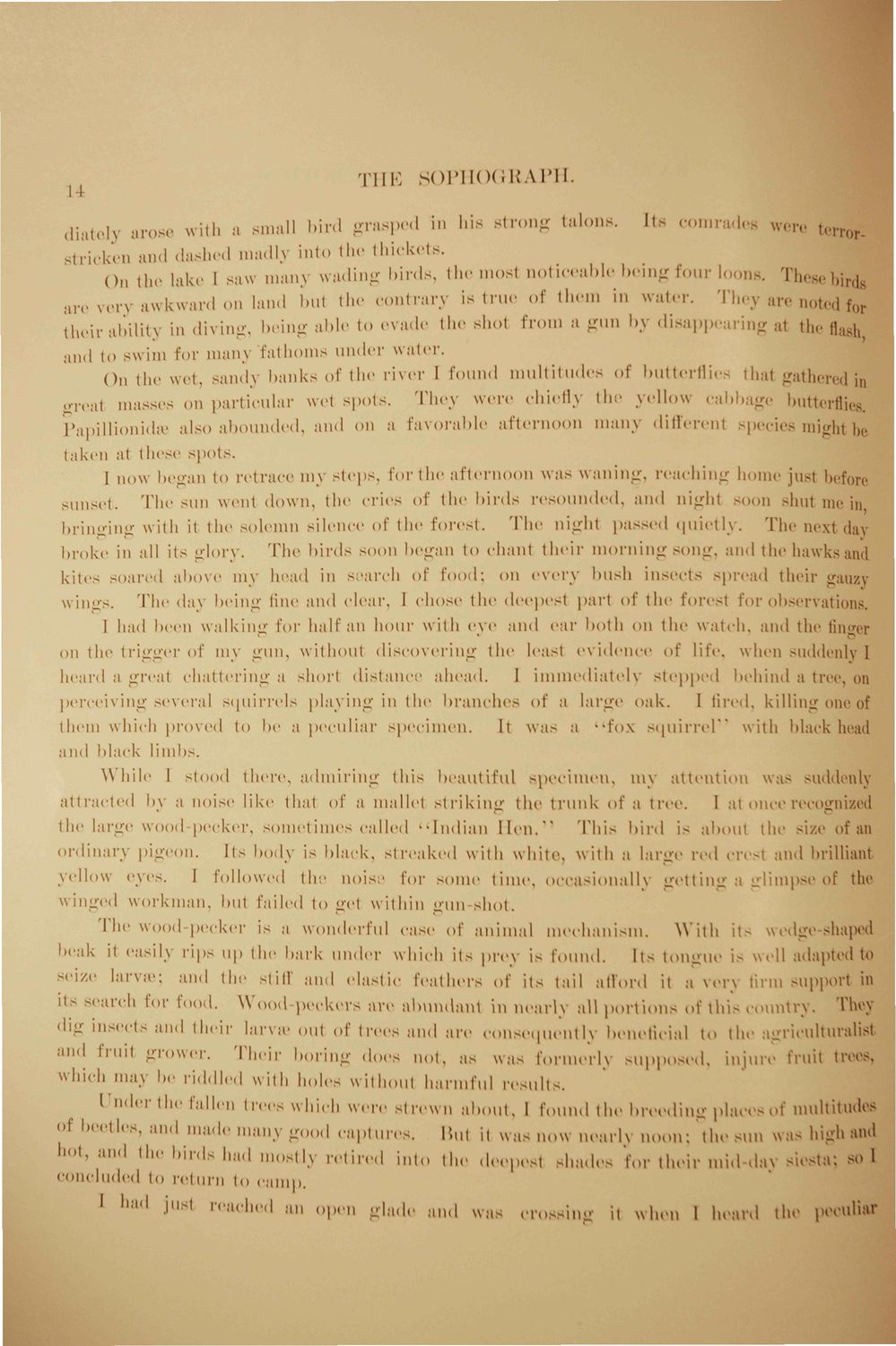| |
| |
Caption: Sophograph - 1893 (Selections)
This is a reduced-resolution page image for fast online browsing.

EXTRACTED TEXT FROM PAGE:
THE SOPHOGRAPH. diatoly arose with a small bird grasped in his strong talons. Us comrades were terrorstricken and dashed madly into the thickets. On the lake I saw many wading birds, the mosl noticeable being four loons. Thesebirdg are very awkward on land bul the contrary is Inn- of them in water. They are noted for their ability in diving, being able to evade the shot from a gun by disappearing at the Hash, and to swim for many fathoms under water. On the wet, sandy hanks of the river I found multitudes of butterfly that gathered in grcal masses on particular wet spots. They were chiefly the yellow cabbage butterflies. Papillionidw also abounded, and on a favorable afternoon many different species might be taken at these spots. I now began to retrace my steps, for the afternoon was waning, reaching home just before sunset. The sun went down, the erics of the birds resounded, and night soon shut me in bringing with it the solemn silence of the forest. The night passed quietly. The next dav broke in all its glory. The birds soon began to chant their morning song, and the hawks and kites soared above my head in search of food: on every hush insects spread their gauzy wings. The day being line and clear, I chose the deepest part of the forest for observations. I had been walking \'^v half an hour with eye and ear hoth on the watch, and the finsrer on the trigger of my gun, without discovering the least evidence o\' life, when suddenly I l i t * I , heard a great chattering a short distance ahead. I immediately stepped behind a tree, on perceiving several squirrels playing in the branches ^\' a large oak. I fired, killing one of them which proved to be a peculiar specimen. It was a -i'ox squirrel" with blackhead and black limbs. While I stood there, admiring this beautiful specimen, my attention was suddenly attracted by a noise like that of a mallei striking the trunk oi' a tree. 1 at once recognized the large wood-pecker, sometimes called "Indian Hen." This bird is about the size of an ordinary pigeon. Its body is black, streaked with white, with a large red crest and brilliant yellow eyes. I followed the noise for some time, occasionally getting a glimpse of the winged workman, hut failed to get within gun-shot. rhe wood-pecker is a wonderful ease of animal mechanism. With it- wedge-shaped beak it easily rips up the hark under which its prey is \\)\wu\. It- tongue is well adapted to seize larva- and the still' and elastic feathers of its tail afford it a \ er\ firm support in its search for food. Wood peckers are ahuudaut in nearly all portions o\' this country. They dig insects and their larva* out of trees and are consequently beneficial to the agriculturalist ;,,1<l f r u i t grower. Their boring does not, as was formerly supposed, injure fruit trees, which may he riddled with holes without harmful result-. r the fallen lives which were strewn about, I found the breeding places of multitude of beetles, and made many good captures. But it was now nearly noon: the sun washighand hot ;,,,(l lll( > ' birds had mostly retired into the deepest shades for their mid da\ -iota; sol concluded to return to camp. 1 ,,, ,<, 1 Q(le ' J ,lsl Poached an open glade and was crossing it when I heard the peculiar
| |